App/Mobile App Localization: The Ultimate Guide
Table of Contents
- What is Mobile App Localization?
- Why Mobile App Localization Matters
- 7 Steps to Master Mobile App Localization
- Mobile App Localization: Going Beyond Translation
- How to Boost Your App Store Visibility?
- Ensure Localization Quality Through Testing & QA
- How to Overcome Common Challenges in Mobile App Localization?
- Stay Ahead of the Game: Future-proofing Your Localization Strategy
- Conclusion
Related Articles
- Localization Strategy: Everything You Need to Know
- Understanding Software Localization: A Comprehensive Guide
- AI Localization: Mastering Global Reach with Best Practices
What Exactly is Mobile App Localization?
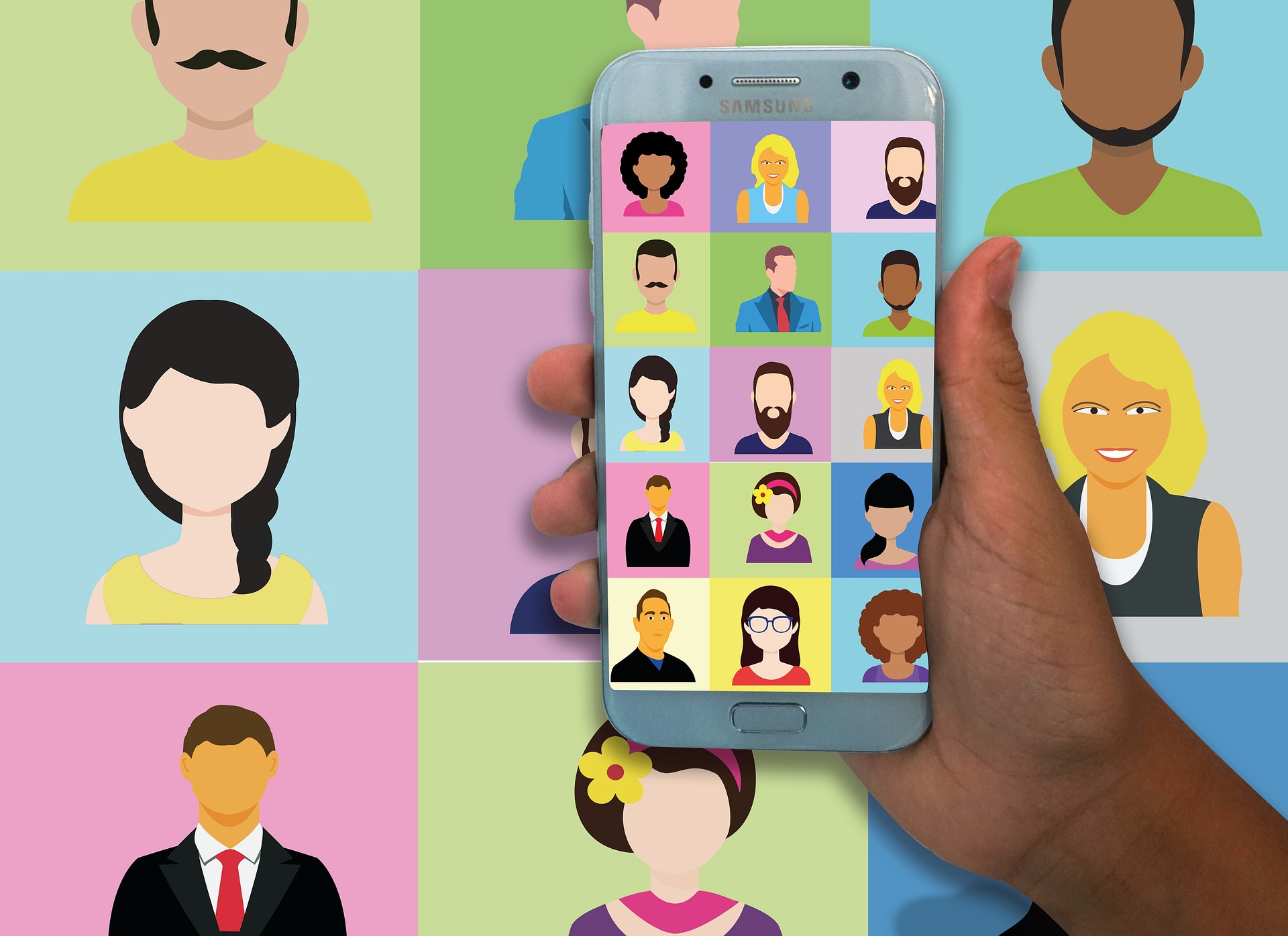
At its core, mobile app localization is the process of adapting your app not only for different languages but also for cultural nuances, local practices, and regional specifics.
In 2024 alone, an astounding 137.8 billion apps and games were downloaded, highlighting the immense competition in the mobile app market.
To truly stand out and outperform other apps, effective localization is essential; it ensures that your app resonates with users on a personal level, catering to their unique preferences and enhancing their overall experience.
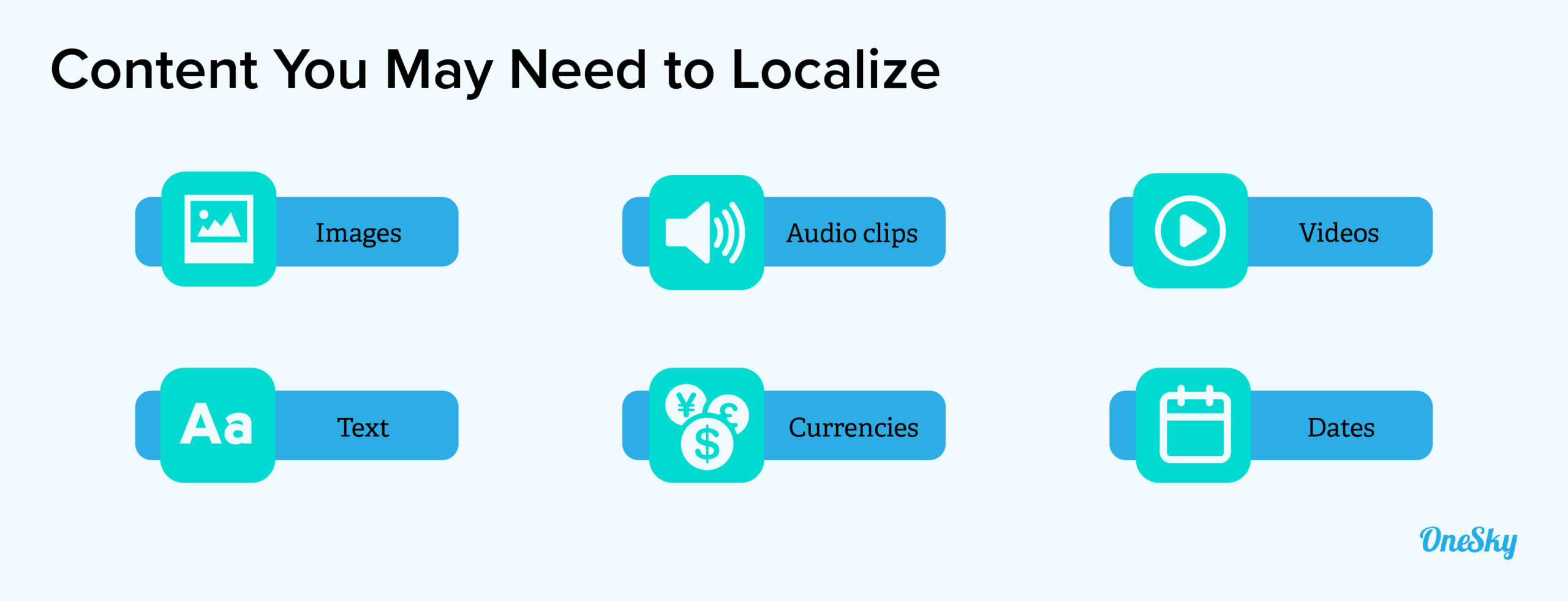
By investing in localization, you can significantly increase your chances of capturing a share of these staggering download figures. This includes both the content within the app, and the app store content used to promote your product.
Localization means:
- Translation of Text: Converting the app’s interface and content into the target language.
- Cultural Adjustments: Adapting images, symbols, graphics, and any culturally specific references.
- Technical Adaptations: Modifying currencies, date formats, and measurements to align with local preferences.
This comprehensive approach ensures that your app doesn’t merely work in another language—it feels native to your users. Locale optimization is a good example.
Even when users share a common language, they may use it very differently.
For example, there are countless differences between the vocabularies of U.S. English and British English speakers.
In development, each language and location pairing is known as a locale. Here are some common examples, with their universal codes:
- en_US (English – United States)
- en_GB (English – United Kingdom)
- en_AU (English – Australia)
- es_ES (Spanish – Spain)
- es_US (Spanish – United States)
- es_MX (Spanish – Mexico)
In order to provide users with a good experience, it’s important to adapt your UI copy for each locale — including the culture. This will ensure that the interface feels native to users in every location.
Learn More about Localization: AI Localization: Mastering Global Reach with Best Practices
Why Mobile App Localization Matters
Now, you may wonder: why invest in mobile app localization?
The answer is straightforward: a well-localized app engages users in ways that a simple translation cannot.
Here’s why it matters:
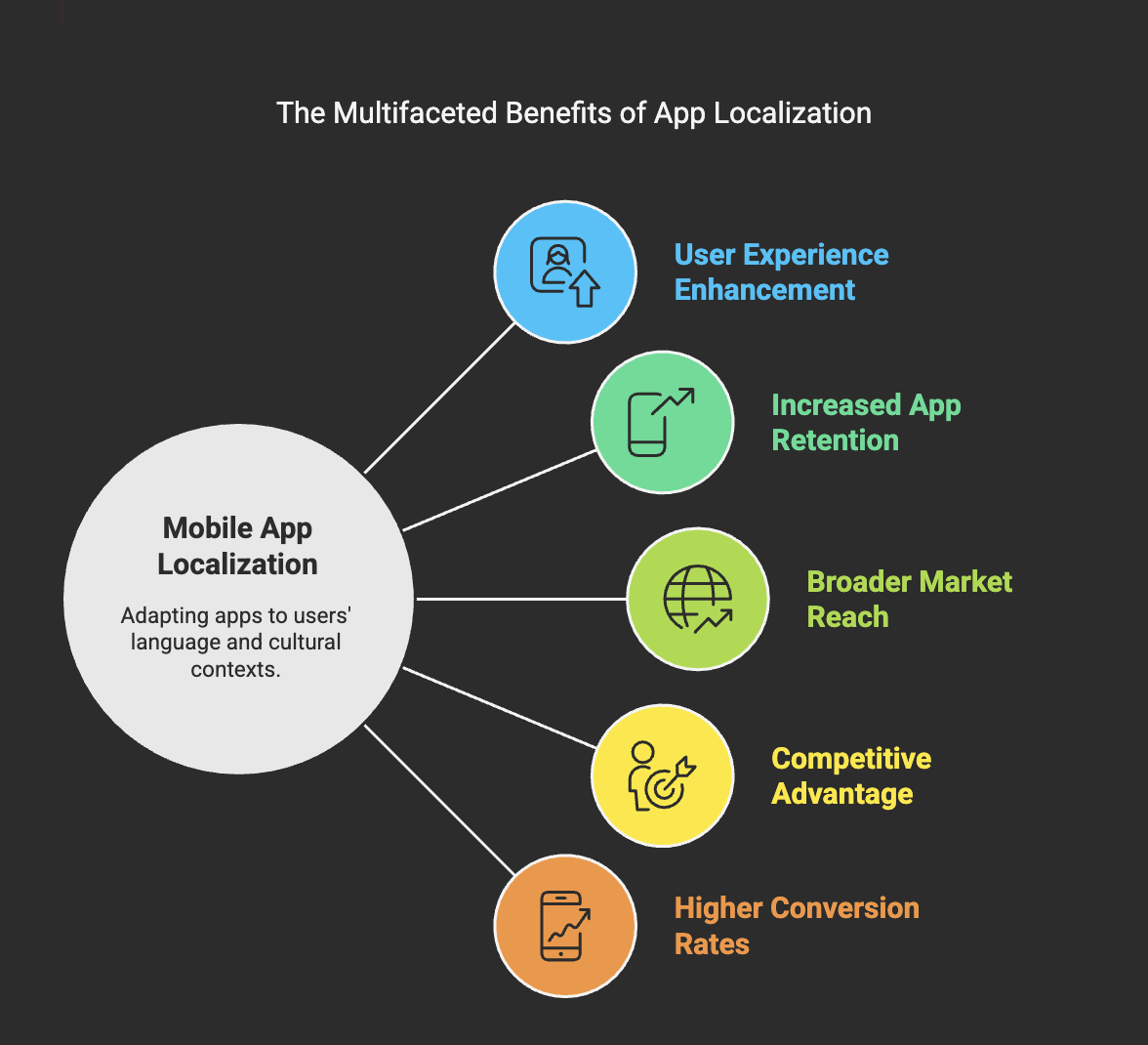
- User Experience Enhancement: A localized app provides a seamless user experience by offering content in a language that users understand effortlessly. It makes navigation intuitive, leading to higher satisfaction.
- Increased App Retention: Users are more likely to stick with an app that feels made for them, reflecting their language and culture. This can drastically enhance retention rates.
- Broader Market Reach: Localization opens doors to new markets. By catering to various regions, you can tap into larger user bases that may otherwise be inaccessible.
- Competitive Advantage: In an increasingly crowded app marketplace, taking the extra step to localize can set you apart from competitors who may only do the bare minimum.
- Higher Conversion Rates: Apps that speak the users’ language and showcase cultural understanding often witness increased conversion rates, whether from downloads or in-app purchases.
Learn more about localization strategy with proven examples here.
7 Steps to Master Mobile App Localization
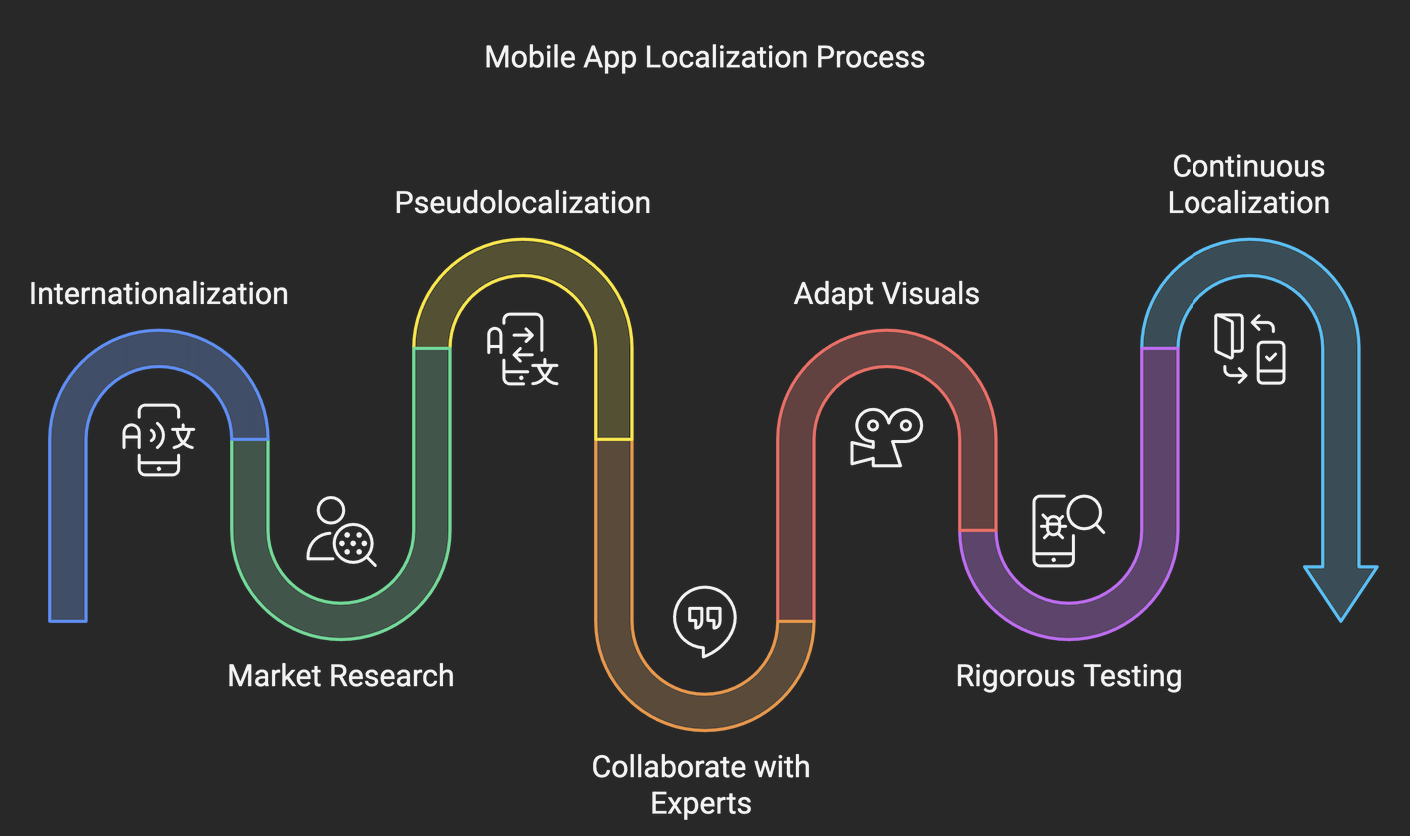
Getting started with mobile app localization may seem daunting, but fear not! We’ve broken it down into manageable steps to ensure you cover all your bases.
Step 1: Internationalization – The Foundation
Before diving into localization, your app needs to be structured with internationalization in mind.
Internationalization prepares your app to handle multiple languages without requiring significant technical changes with each new roll-out.
Here’s what to focus on:
- Flexible Code Development: Make sure your code is designed to accommodate different text lengths and formats. For instance, language expansion can sometimes make messages longer or shorter, affecting layout and design.
- Externalize Text: Store all translatable content and UI text in external files rather than hard-coding them. This practice makes updates and translations much easier.
Investing time in internationalization can save you countless hours down the line.
Step 2: Conduct Comprehensive Market Research
Once you’re ready for localization, it’s vital to deeply understand the markets you want to enter. Each region has its cultural intricacies, user habits, and preferences.
Tip: consider conducting surveys or focus groups to gather firsthand insights.
Key points to address include:
- Cultural Norms and Practices: Familiarize yourself with local customs, holidays, and societal norms. For example, an app for meal delivery should align with local cuisines and mealtime traditions.
- Language Variations: Different countries might speak the same language yet use different dialects or terms. Know your audience well!
- Competitive Analysis: Look at similar apps in your target markets. What strategies are they employing? What’s working, and what’s not?
This thorough research lays the groundwork for effective localization.
Step 3: Implement Pseudolocalization for Testing
For those who are just getting started with localization, the term “pseudolocalization” might sound a bit technical.
Simply put, it’s a method that allows you to prepare your app for future translations by making mock adaptations of the original content. This practice helps you identify potential issues in your app’s design before you actually dive into the translation phase.
Why Use Mock Localization?
Mock localization helps ensure that your app’s interface and user experience can handle different languages and text lengths without problems. By placeholder text, often using exaggerated formats or lengthened versions of the original content, you can see how well your app accommodates these changes.
Here’s How to Do It:
- Create Mock Translations: Replace your app’s original text with “mock” translations. These could be gibberish versions that adopt different lengths and characters. For example, you might change “Hello” to “Hëllö” or make longer phrases to test your layout.
- Identify Layout Issues: As you view the app with these mock translations, observe how the interface reacts. Are any buttons overlapping? Is the text cutting off? Catching these errors early is crucial for a smooth localization experience later on.
Step 4: Collaborate with Local Experts
Next up is ensuring that you collaborate with local experts who understand not just the language but also the context surrounding it. This can substantially enhance the quality of your localization.
Here’s how to leverage local insights effectively:
- Engage Native Linguists: Partner with translators who are native to the target market. They will help ensure that your app doesn’t just translate the words but also conveys the right meaning and feel for the audience.
- Utilize Localization Agencies: These agencies specialize in making content resonate culturally and linguistically. They can also provide valuable advice on market trends and user behavior.
- Seek Cultural Advisors: Understanding cultural significance is crucial. Cultural advisors can help you navigate sensitive topics or local customs that may impact how your app is received.
Step 5: Culturally Adapt Your Visuals
When localizing your app, visuals play just as important a role as the text.
It’s vital to adapt images, colors, and symbols according to cultural preferences, making sure your app feels right at home regardless of where it’s being used:
- Address Color Perception: Understand that colors have different meanings in different cultures.
For instance, while green represents wealth and prosperity in the U.S., it may have different connotations in countries like China. - Symbolic Sensitivities: Images and symbols can often carry cultural significance that might not be appropriate or effective in another context.
Be careful when using cultural imagery to ensure it aligns with your target market’s values. - Responsive UI Design: Visual elements need to be adaptable to accommodate translations and different text lengths. This level of attention to detail helps maintain an appealing user interface across localized versions.
Step 6: Rigorous Testing – Ensure Quality Across Markets
Once the localization process is underway, rigorous testing becomes essential.
It ensures that not only the text but all app functionalities meet user expectations everywhere:
- Linguistic Testing: Check for linguistic accuracy through review by native speakers. They can evaluate if the translations are correct, idiomatic, and culturally appropriate.
- Functional Testing: Test the full functionality of the app across devices and operating systems to ensure everything operates smoothly, regardless of the user’s environment.
- User Acceptance Testing: Engage actual users from the target market to test the app. Their feedback will illuminate any hidden issues and give you insights into how the app performs in the real world.
Mobile App Localization: Going Beyond Translation
Translating your content from one language to another is the most basic form of localization. But to thrive in foreign markets, you will need to go further.
Cultural differences often create an invisible ceiling for marketing campaigns, and even a brand name may lose its resonance when translated directly.
For example, in the world of entertainment, it’s common for entire franchises to be renamed to suit different markets.
Take the popular Spanish Netflix show, La Casa de Papel. Translated literally, the title means “The House of Paper.” But in English-speaking markets, the show is known as Money Heist, and German viewers enjoy Haus des Geldes (“House of Money”).
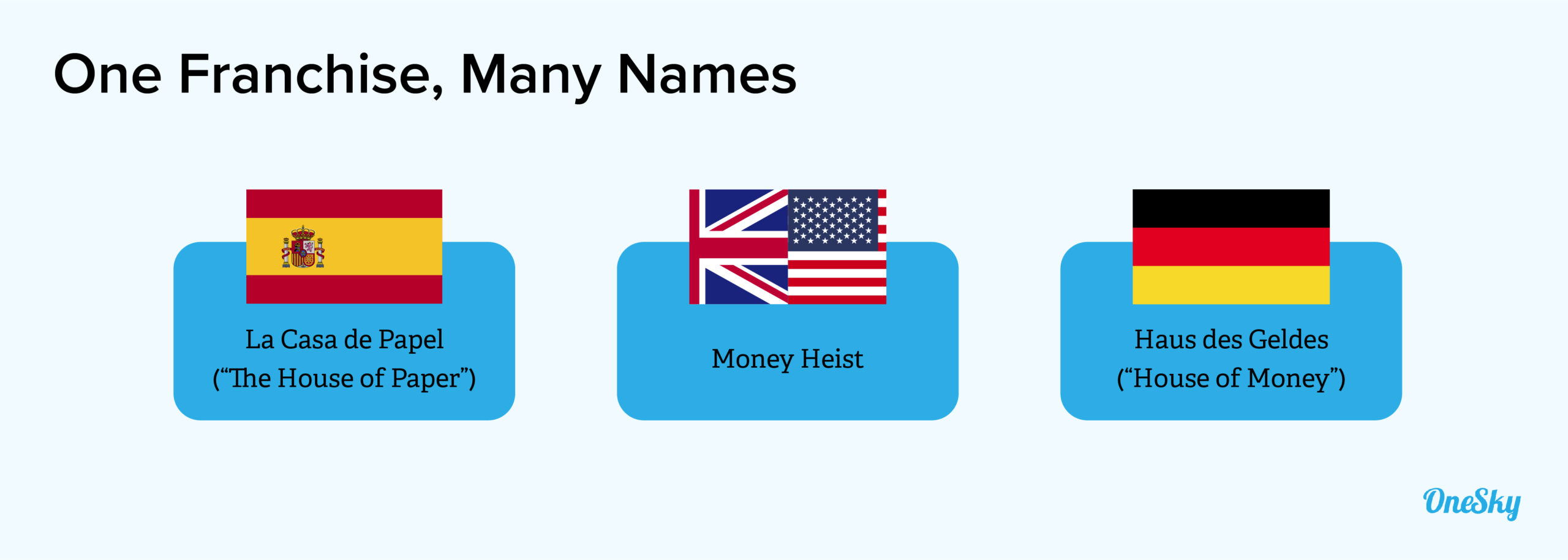
While app stores generally do not allow this level of creative freedom, it’s worth working with an experienced translator to optimize your content and branding for each market.
How to Boost Your App Store Visibility?
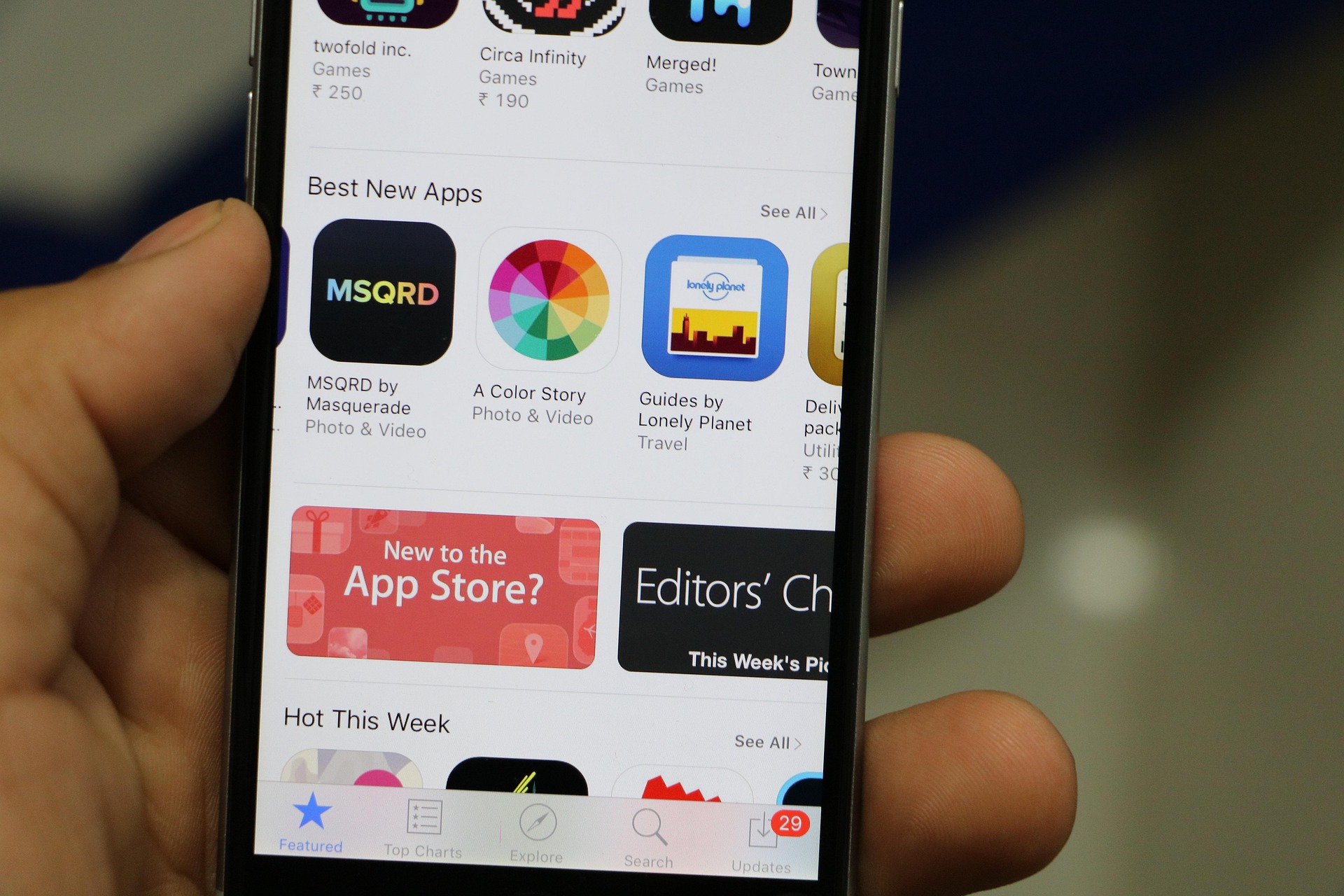
App Store Optimization (ASO)
To unlock the full potential of your app’s presence in the app store, optimizing for search is essential.
App Store Optimization (ASO) involves fine-tuning critical elements—such as your app title, keywords, and descriptions—to enhance discoverability among potential users.
Key ASO Strategies:
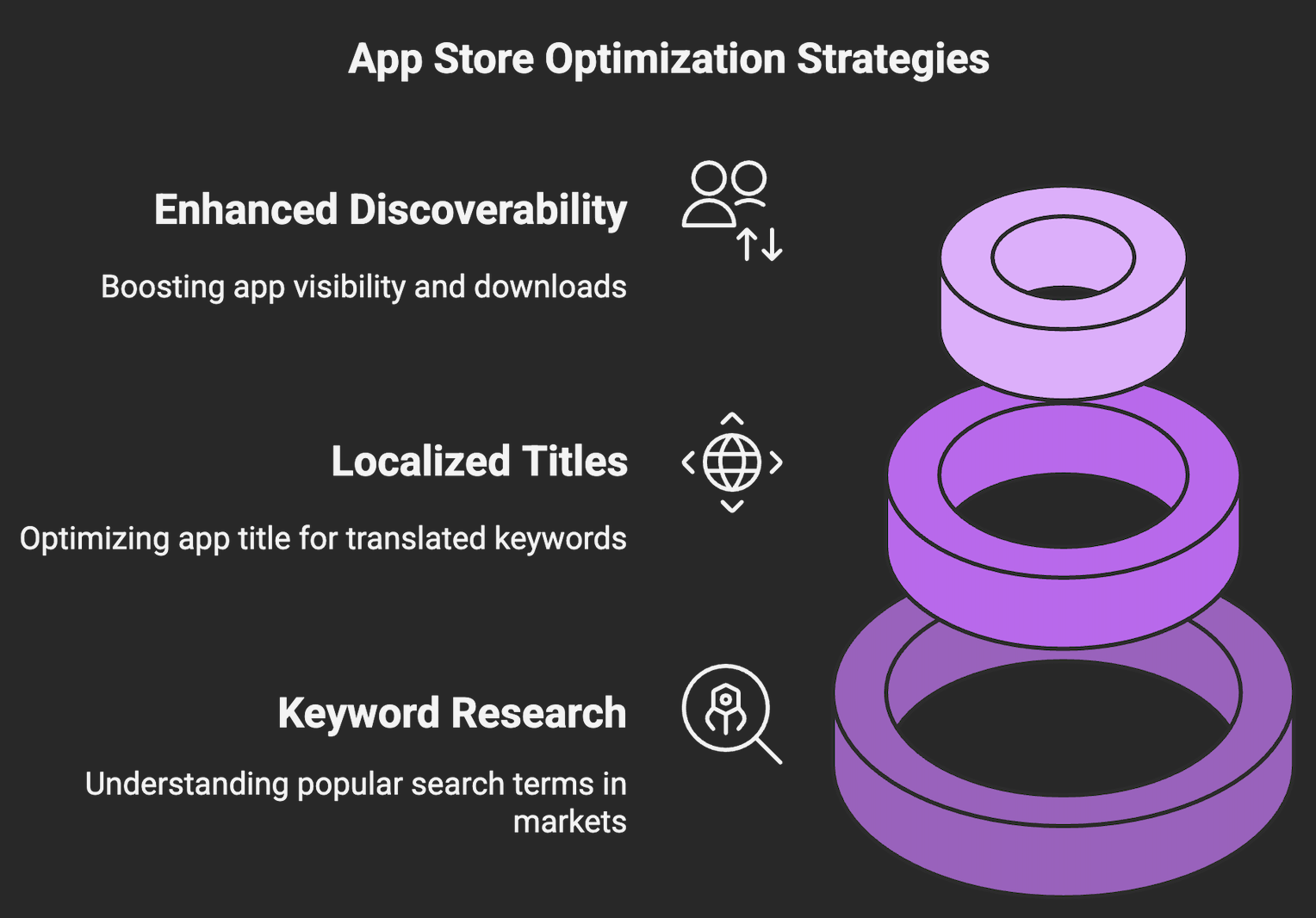
- Keyword Research: Dive deep into understanding the most popular search terms in each market. This research lays the groundwork for a successful app store listing.
- Localized App Titles and Descriptions: Once you’ve gathered your keywords, ensure that your app’s title and description are not only translated but also optimized for these terms. Tailoring your content will help your app rank higher in search results and catch the attention of users.
By implementing strong ASO practices, you can significantly boost your app’s visibility and attract more downloads right from the start.
Localization
With your ASO foundations in place, it’s time to turn your attention to localization.
Properly localizing your app store listings is crucial, as these often serve as the first point of contact with potential users.
Here’s how to make your app store presence shine.
Essential Localization Elements:
- Localized Titles and Descriptions: Beyond mere translation, ensure your app title and description are fine-tuned for local search terms. Using relevant keywords will enhance visibility in each target market.
- Screenshots and Visuals: Incorporate localized screenshots that resonate culturally with your audience.
For example, if your app is focused on food delivery, showcase images of popular local dishes instead of generic food. This visual connection can make your app more appealing to potential users. - Engagement through Reviews: Don’t overlook the power of social proof. Using localized reviews and testimonials can help establish trust with new users. Positive feedback from local users can go a long way in influencing downloads.
Mastering the App Store Showdown: Apple vs. Google Play!
Tailor your approach to shine on both platforms.
Apple’s App Store Localization
Apple’s App Store has a strict limit of 100 characters for its keyword field, so you need to make every character count. Be strategic in your choices—every word is precious!
To update your iOS app with new localization, you will need to visit App Store Connect and navigate to My Apps > App Information.
Here you will be able to create a new version of your app and select the locales it is optimized for.
Google Play Localization
On the flip side, Google Play offers a more vibrant experience. It showcases a prominent feature graphic at the top, followed by your app icon, ratings, a brief description, and a lively gallery of screenshots.
With such an eye-catching layout, it’s crucial to customize these visuals for the Android audience to create a strong connection.
On Android, localization happens through your Google Play Console.
You don’t need to create a new version — just head to Store Presence > Store Listing and enter a localized title and description.
In short, by investing the time and effort to localize your app store listings, you set a positive tone for potential users right from the beginning, increasing the chances that they’ll take a chance on your app.
Remember, a localized app store listing is just as important as the localization of the app itself!
Ensure Localization Quality Through Testing & Quality Assurance
Once your localization resources are in place, you might think you’re all set—time to hit “publish,” right?
Not quite!
It’s absolutely crucial to test your app thoroughly before it reaches users.
Skipping this step could lead to frustrating mistakes that undermine the user experience, so let’s break down how to ensure quality through effective testing and quality assurance (QA).
Start Testing Early
It’s wise to initiate localization testing early in the process.
By addressing layout problems or text expansion issues before the app goes live, you can avoid costly fixes down the line.
Early testing leads to better outcomes and saves resources. Research shows that identifying and resolving bugs during the initial stages can lead to cost reductions of up to ten times compared to fixing them post-launch.
So, engaging designers and QA teams early in the localization flow can pay off significantly.
Smoke Testing & Soft Launch
The process of localization can sometimes alter how your app works. For instance, a change in the length of strings may affect the interface layout.
For this reason, it’s a good idea to conduct “smoke testing” — where a member of your team uses the app without understanding the translation. Such tests can reveal performance issues, which you can fix before the next stage of testing.
You may then wish to soft-launch the newly localized version of your app with a small group of testers from the target locale. This should pick up any glaring discrepancies in the translated content. OneSky offers on-device testing as part of the end-to-end workflow.
Utilize Localization Tests
Incorporating localization tests allows you to detect any design inconsistencies early on. These tests help you ensure that the app’s user interface remains intact, with text fitting neatly within the designated spaces, regardless of the language.
For instance, if one translation is longer than the original, it could interfere with the layout, causing buttons to overlap or text to get cut off.
Catching these problems early is key to providing a seamless experience for users around the globe.
Pre-Production Quality Assurance
As you approach the finish line, conducting pre-production quality assurance (QA) is essential.
This step allows your internal teams—whether they be stakeholders or QA specialists—to test your app with the translations integrated from your translation management system.
- Test the app for final feedback, ensuring that everything functions correctly.
- Update any strings that may require adjustment based on this feedback.
- Instantly push changes to production, allowing for quick iterations.
By focusing on these testing practices, you help ensure that your app is polished and ready for users in every market.
In the end, a commitment to thorough testing and quality assurance not only enhances user satisfaction but also boosts your app’s reputation in an increasingly competitive landscape.
How to Overcome Common Challenges in Mobile App Localization?

Can’t wait to launch your app globally? Hold on—before you dive in, be prepared for some common roadblocks that can trip you up on the localization journey.
Here’s a rundown of challenges you might face, along with handy tips to help you sidestep them like a pro:
Increased Time to Market and Costs
While it’s crucial to localize your app before launch, the wait can be excruciating. Translation delays can slow down feature releases, leaving your developers twiddling their thumbs.
Our Insider Tips:
Establish a solid localization workflow right from the start!
Look for ways to streamline the process so localization and development can run in parallel. This not only helps you hit your launch date but also keeps costs in check.
A little upfront planning can save a lot of headaches later.
Figuring Out How Much to Localize
Localization needs can vary.
Sometimes, translating between similar dialects—like American and British English—can feel redundant. Without a clear strategy, you might miss out on critical adjustments.
Our Insider Tips:
Be mindful of cultural nuances as you localize.
Even minor differences in expression or terminology can impact user perceptions.
Conduct thorough research to gauge the necessary level of localization for each market, ensuring your app resonates with local audiences.
Missing Cultural Context
Machine translation can be a lifesaver, but it can also miss the mark when it comes to capturing cultural subtleties.
What’s friendly in one culture might be offensive in another!
Our Insider Tips:
Pair machine translation with human oversight.
Engage local linguists who understand the language and culture. They can help you navigate these nuances and ensure your app feels relatable and friendly across different markets.
Managing Text Expansion and Layout
Did you know that translated text can often expand significantly?
For instance, it’s observed that German translations generally take up more space than English. Oversights here can lead to layout issues that compromise user experience.
Our Insider Tips:
Anticipate potential text expansion when designing your app.
Prepare flexible layouts that can accommodate varying text lengths, and conduct testing to see how your app looks in different languages.
This proactive approach keeps your user interface intact, regardless of the language.
Navigating Right-to-Left Languages
If you’re localizing for right-to-left languages like Arabic or Hebrew, be prepared for a UX shakeup.
Too often, companies optimize for left-to-right languages and forget that right-to-left users have entirely different expectations.
Our Insider Tips:
Take the time to redesign UI elements so that they cater to right-to-left readers.
A simple repositioning of navigation buttons can make a world of difference. Always put yourself in the users’ shoes—I mean, who likes fumbling around in an app?
Losing Sight of the Bigger Picture
In the thick of localization, it’s easy to get bogged down by details like maintaining brand voice or stylistic elements, losing focus on what really matters: the user.
Our Insider Tips:
Keep your customers front and center!
Make sure every localization decision serves their needs. This focus will not only enhance user experience but also strengthen your brand loyalty and encourage conversions.
Localization Lagging Behind Development
When localization is treated as a separate process, it often slides to the back burner. This can cause frustrating delays and misalignment with new feature rollouts.
Our Insider Tips:
Integrate localization into your agile development framework.
Continuous collaboration between developers and localization teams ensures everyone stays on the same page, allowing for a more fluid process where updates are timely and effective.
Not Utilizing the Right Technology
Trying to navigate localization without the right tools can lead to inefficiencies and mistakes flying under the radar. This can slow down releases and lower the quality of your app.
Our Insider Tips:
Invest in a dedicated app localization platform that simplifies and automates processes.
The right tools can centralize your localization efforts, improve communication, and make collaboration a breeze. This means fewer headaches and quicker turnaround times.
Stay Ahead of the Game: Future-Proofing Your Localization Strategy

As the digital world evolves, so too should your localization strategies.
Here are some key trends to watch that can win on the battlefield of mobile app localization:
- Embrace Hyperlocalization: Users increasingly crave experiences that reflect their specific cultural contexts.
Hyperlocalization goes beyond just translating text—it’s about customizing your content to fit unique cultural preferences and nuances. - Leverage Automation and AI: With the rise of sophisticated AI tools, you can streamline processes like translation and gather valuable cultural insights.
Keeping pace with the latest technology can save you time and significantly enhance the quality of your localization efforts. - Prioritize User Experience (UX): Effective localization is not just about translating words; it’s about shaping an entire user experience.
Focusing on UX design for each market will strengthen user engagement and satisfaction.
By keeping an eye on these trends, you can ensure your localization strategy remains proactive and relevant, allowing your app to connect with users across various markets effectively.
Stay ahead of the curve, and watch your global reach grow!
Conclusion
In summary, successful mobile app localization is a multifaceted endeavor that requires a thoughtful approach and a deep understanding of your target markets.
By investing the necessary time and resources into each step—from early internationalization to rigorous testing and continuous engagement—you position your app for widespread appeal and success.
With the right tools, a collaborative team, and a commitment to cultural authenticity, your application can make a genuine connection with users around the world.
As you embark on your localization journey, consider leveraging a powerful localization management solution like CoFluent AI by OneSky.
Designed to simplify and enhance the localization process, OneSky offers a user-friendly platform that connects your development and translation teams seamlessly. With features like translation memory and project management tools, you can streamline your workflow, ensuring that your app is always aligned with local preferences.
Ready to elevate your mobile app localization efforts? Explore OneSky today and discover how we can help you make your app feel like it was built specifically for each user, no matter where they are.
Let’s unlock the full potential of your app together!

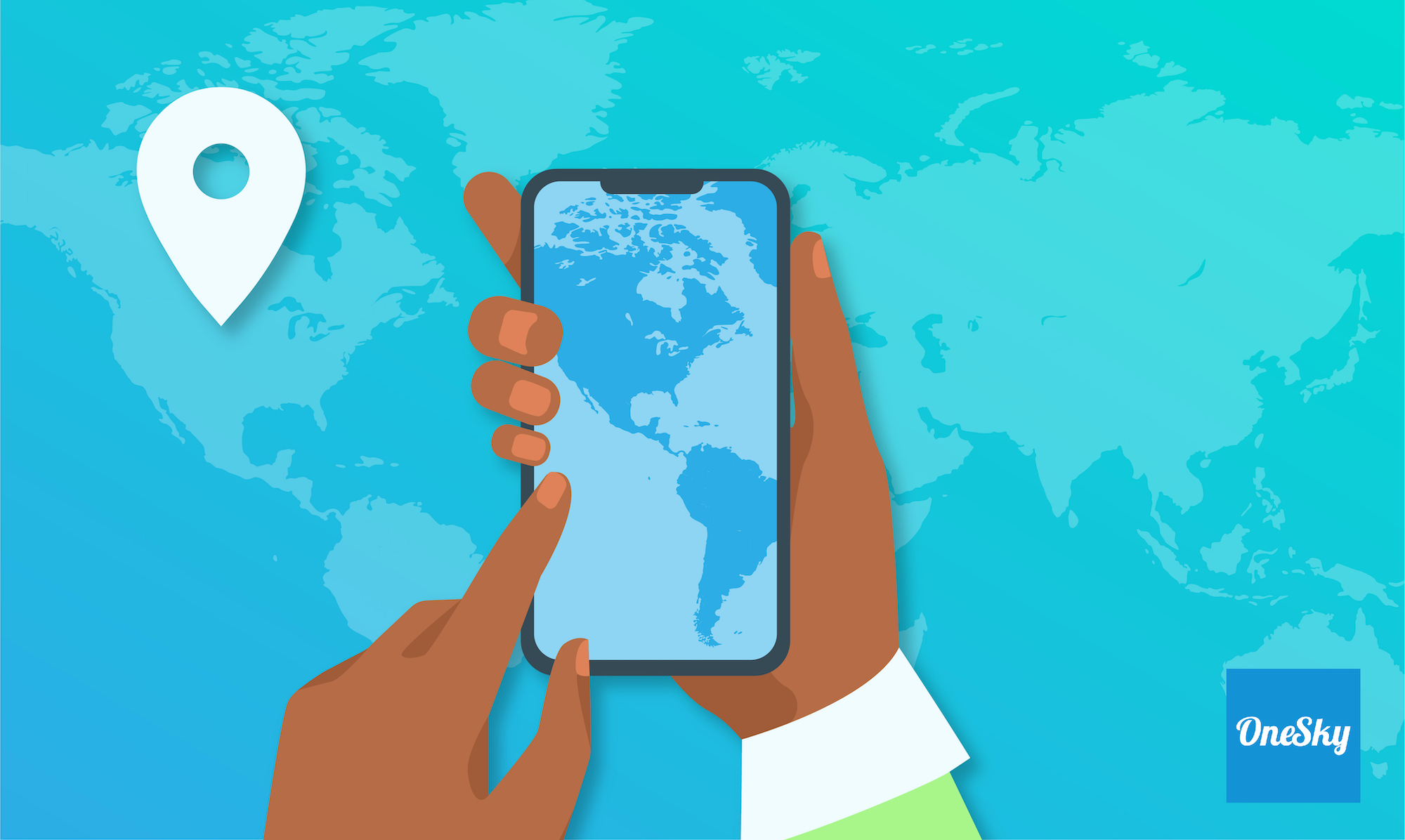

 Written by -
Written by - 




 Written by
Written by 



This guide is an essential resource for understanding the importance of localization, especially for app development companies looking to expand their global reach.